
The ordinary orange construction cone has become a symbol of resistance in an insurgency against self-driving vehicles.
Members of a group called Safe Street Rebel started placing construction cones atop the hoods of robotaxis last month in San Francisco. The action renders the cars unable to continue driving until a human removes the cones or reboots their systems.
The vigilantes began their vehicular mischief — it quickly became known as “coning” — ahead of a controversial vote this month in which the California Public Utilities Commission approved the expansion of commercial self-driving service throughout the city.
That green light came over the objections of the San Francisco Municipal Transportation Agency and city police and fire department officials, all who said self-driving vehicles often interfere with emergency responders and cause traffic fiascos.
Both Waymo and Cruise, the two robotaxi companies operating in San Francisco, declined to say how many times their cars have been coned.
Frequency of the incidents has dramatically slowed since the Aug. 10 vote, according to Cruise. Hannah Lindow, a spokeswoman for the company, said the coning efforts were “tied to that moment” and anticipated the protests will fade.
Waymo declined to comment.
But Safe Street Rebel organizers plan to continue their battle against self-driving vehicles, particularly as the municipal transit agency petitions state regulators for a formal reconsideration of their decision. The vote permitted Cruise to expand in the city and Waymo to begin commercial service.
“It’s definitely not over,” Andy, a 27-year-old representative of Safe Street Rebel told Automotive News. “There are more opportunities for pushback.”
He declined to provide his full name in part because he feared legal repercussions from the coning incidents.
It remains unclear whether coning cars violates local ordinances or state laws. California’s penal code describes vandalism as “maliciously damaging, destroying or defacing” property, and Safe Street Rebel said its actions constitute none of the above.
Kathryn Winters, a San Francisco Police Department spokesperson, said she had no information about any arrests or “any police action” against people for coning cars.
Andy bristled at the word “vandalism” and preferred “shenanigans” to describe coning activity. He had another reason for declining to share his full name: He codes and works in the tech industry. He does not want to be branded a Luddite, even if he said the term accurately reflects his perspective on robotaxis and technological progress in general.
Many Safe Street Rebels have careers in the tech industry, he said, and “we’re skeptical of it because we work with it.”
Such expertise can breed reservations, and that parallels the experience of the actual Luddites, English textile workers who rebelled against the use of machinery at the dawn of the factory age in the early 1800s.
The Luddites did not advocate for a wholesale rejection of technology, said Brian Merchant, author of Blood In The Machine: The Origins Of The Rebellion Against Big Tech, which publishes next month. Rather, many Luddites worked with innovative machines and techniques in their own homes, and wanted to ensure more widespread adoption did not exclusively benefit society’s elite at the expense of everyone.
In some respects, that jibes with Safe Street Rebels’ resistance to the self-driving cars proliferating throughout San Francisco.
“If you are confronting a technology or resisting it because that technology is a direct threat to your community or way of life, then being a Luddite should be encouraged,” Merchant said. “The activists who are coning cars in San Francisco should embrace the term. They’re engaging in Luddite action and, in many ways, an admirable one.”
Robotaxi companies, not surprisingly, disagree.
Despite a crash involving one of its vehicles and a city fire truck one week after the decisive California Public Utilities Commission vote, Cruise said its robotaxis offer safe transportation. The company further said its vehicles provide reliable late-night rides for workers and that its cars have delivered more than 2 million meals to city residents who might otherwise go hungry.
“Intentionally obstructing vehicles gets into the way of those efforts and risks creating traffic congestion for local residents,” Cruise’s Lindow said.
Safe Street Rebel is one of several groups taking transportation-related matters into its own hands.
In 2020, a group of Detroit parents paid for and installed a speed hump on a residential street to protect children from speeding motorists. City officials tore it out.
Frustrated with inaction from local officials, the safe-street advocacy group Crosswalk Collective LA painted crosswalks at intersections lacking them throughout Los Angeles in 2022.
“The city of Los Angeles doesn’t keep us safe so we keep us safe,” the group said. In some cases, they said, the city erased their work. Others were upgraded into formal crosswalks. Some were left as is.
Activists took more nefarious action last year in New York. The Tyre Extinguishers deflated tires on dozens of SUVs, saying the vehicles threatened traffic safety and the climate.
The group’s members left behind flyers on the windshields of their vehicular victims, which in part read: “You’ll be angry, but don’t take it personally. It’s not you, it’s your car.”
San Francisco would be better served by encouraging increased public transit use, biking and walking, Andy said. He said he protests AVs because replacing human-driven taxis or ride-hailing vehicles with automated drivers solves no climate concerns or broader congestion issues.
Other members of the group believe the vehicles are unsafe. Some believe robotaxis may be safer than humans in certain ways, but introduce new modes of failure into the traffic environment. Some are aggravated by the interference with emergency responders.
Robotaxis are a mobile manifestation of technology — and sitting ducks. Coning them is one way to strike a blow against Big Tech.
“Tech is such a large and powerful presence there,” Merchant said. “Long-term residents increasingly feel like they’re being elbowed out of their community by tech interests. … so you can see why you get frustration turning into direct action.”

